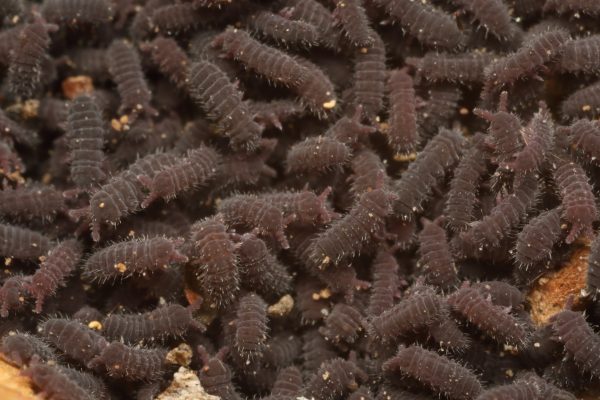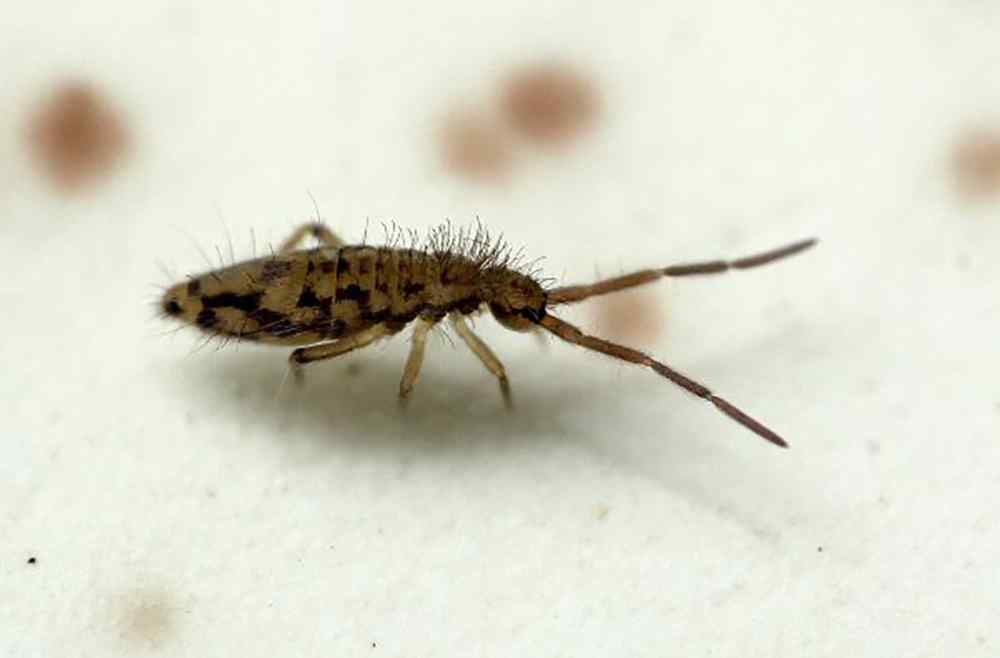Have you noticed little flea-like creatures crawling about in your home?
Every homeowner dreads the day when unwanted pests enter their home. Unwanted insects and pests can damage your home and can potentially harm you and your family.
If you’ve noticed flea-like insects in your home, you may have a springtail infestation. The good news is these tiny insects are fairly harmless to humans. The bad news is they can grow to frighteningly high numbers and cause problems in your home if ignored.
Do you think you might have springtails in your home? Read on to learn what they are and how you can get rid of them.
What Is a Springtail?
Springtail, sometimes known as snow fleas, are tiny wingless insects. They have an elongated body with a length of about 1/16th of an inch. Their bodies are dark gray, white, black, or blue.

These wingless insects don’t fly but hop from place to place, much like a flea. Under their abdomen, they have a tail-like appendage called a furcula to jump into the air. They can hop as high as three to four inches.
Springtails love moist environments and will lay their eggs in moist areas, typically soil. Unlike fleas, springtails don’t feed off of living creatures such as yourself or your pets.
Instead, they prefer to eat decaying matter and sometimes eat the leaves and roots of living plants. This makes them a valuable part of the natural environment.
Their small size and seemingly harmless natures cause most homeowners to ignore them. If left unchecked, these tiny insects can grow to immense numbers, in some cases as high as 30,000 or 50,000. They can wreak havoc on your gardens, flowers, and any indoor plants.
Springtail Environment
Springtails thrive in moist areas. Without moisture, they will dehydrate and die.
Springtails can live in a variety of dark, moist environments. They can thrive well in warm wet summery conditions as well as the winters.
Yes, springtails enjoy the snow and will thrive in the harsh temperatures of the winter months. Many homeowners may find them active in the middle of winter. They attract to warm foundations and will sometimes pop up on the surface of the snow.
Springtails can’t live on the surface of the snow for very long and will need to retreat to their moist soils. If you find springtails crawling in the snow around your house during the winter, it’s a clear sign you have a springtail problem.

You can find springtail across the United States. They’ll stick to organic natural areas full of moisture, mold, and mildew in most cases. They feed on rotting organic materials such as fungi, mold, decaying plants, and algae.
A few places you can find them outdoors include your compost, leaf litter, and organic mulches. They enjoy well-watered garden beds, stagnant water, and areas around a swimming pool. They’re present in most agricultural fields, gardens, and piles of wood.
What do springtail insects do when the weather turns dry?
How a Springtail Infestation Gets Into Your Home
While springtails prefer the outdoor environment, they will start looking for dark, moist places when their environment gets dry. The most common places include your gardens and your home.
They can enter your home through any openings they can fit. The most common points of entry include:
- Doors
- Windows
- Cracks in the foundation
- Pipes and plumbing
- Vents
- Garage doors
- Crawl spaces
- Siding
Once they’ve entered, they will find and congregate in the moist areas of your home. Depending on your home, you can find them in your kitchen, bathrooms, garage, or basement. When their populations grow, they can inhabit multiple places.

In your kitchen, springtails are likely to congregate in the piping and cabinetry under your sink. Springtails love the moist areas around your bathroom sinks, bathtubs, and toilets.
If you have damp areas in your basement, the springtails will find it and congregate.
Springtails can inhabit areas inside your walls and under the floors near plumbing leaks. They can thrive in and under damp sheetrock or anywhere where mold, mildew, and fungus grows.
Springtail Damage
Most homeowners overlook springtails when they are first settling in or around your home. If you’re like most, you won’t notice a springtail infestation until they’ve settled. At that point, you likely have thousands of springtails thriving in and around your home.
Springtail infestations can grow to crazy high numbers. This will cause them to spread and make it more difficult for you and your family to get rid of them. They’ll start as an annoyance before evolving into a bigger problem.
In severe cases, a springtail infestation can cause some damage to your home or personal items. Springtails may not appear as bad as carpet beetles, termites, or other pests because their damage isn’t as progressive. Most springtails won’t damage your home’s indoor structures and features.
Still, you shouldn’t ignore a springtail infestation.
Preventing Springtails
The only way springtails can survive is with moisture. By eliminating high amounts of moisture in and around your home, springtails will have difficulty surviving.
The most effective way to prevent springtails is to keep your home dry. Start by focusing on ways you can eliminate excess moisture from building up in and around your home.
Keep Your Yard Dry
Let’s start by exploring ways you can keep your lawn and gardens drier. No, you don’t need desert landscaping, and you don’t need to kill your lush gardens to do this.
Avoid overwatering your gardens and lawns. More watering means the soil will be damper. If you suspect you have springtails, dry out the soil before watering it, as this will cause most of them to move and die.
When you water your gardens and lawns, water them as needed. This will also cut your water usage while preventing pesky springtails from colonizing.
Are you a homeowner who uses an outdoor or indoor wood stove to heat your home during the cooler months? Start by placing your chopped wood on a palette or platform that lifts the wood off the ground. This will prevent the wood from gathering moisture and attracting springtails.
If you have old piles of damp molding wood in your yard, it’s time to collect and discard them. Remove any standing water in your driveway and yard. Use less mulch in the gardens around your home’s foundation.
Those with compost piles should keep their compost far from the yard and prevent them from getting too damp. If possible, consider using a plastic compost bin as these can help prevent springtails from accumulating.
When was the last time your check and cleaned your home’s rain spouts? These should direct water away from your home. Rainwater can cause areas of moisture to build up around your home’s foundation, which will attract springtails.
Keep Your Home Dry
You’ll need to perform a thorough check inside your home to identify damp, wet areas.
The two biggest problems are plumbing leaks and standing water in your home. If you have either of these, there’s a good chance you may already have springtails living inside your home.
Start by looking for and fixing leaks in your kitchen, bathroom, and basement. Leaks are a major attractor to springtails.
Besides attracting unwanted pests, ignoring a leak will ruin the structural integrity of your cabinetry, flooring, or walls. Leaks can cause mildew and mold to grow, which will ruin your home’s air quality.
Depending on the cause and severity of the leak, contact a local plumbing service to fix it for you. From there, you may need to replace damaged drywall or flooring as these will mold, rot, and continue to attract springtails.
If you have areas of standing water in your unfinished basement, consider adding a water pump to remove the excess water. Those with damp basements should invest in a dehumidifier to prevent moisture buildup and keep their basement dry.
Go through your boxes of stored items, such as old clothes, rags, and more, to check for moisture and mildew. Springtails can and will make a home out of nearly anything, including books, upholstered furniture, and other materials that foster the mold and fungi’ growth.
Don’t forget your garage and storage shed. Both of these places can harbor stagnant water and moisture buildup. You may need to resurface the flooring or fix leaks in the roof and walls to prevent more moisture from entering your garage or shed.
How to Remove Springtail
Have you tried following these preventative measures and still found a colony of springtails thriving in your home?
The next step is pest treatment. Most treatments start with an outdoor spray which you can apply to the exterior perimeter of your house. Next, you’ll need a spray or drain treatment to treat the interior areas.
If the problem continues, you’ll need to look for pest control services.
Don’t Ignore the Springtails
While springtails can appear to be benign, they are a pest that you shouldn’t ignore. By following these tips, you can prevent and remove a springtail infestation from your home.
Have questions or need professional pest control help? Contact us about our premium quality pest control services today! We’re here to keep you, your family, and your home safe from unwanted pests.
